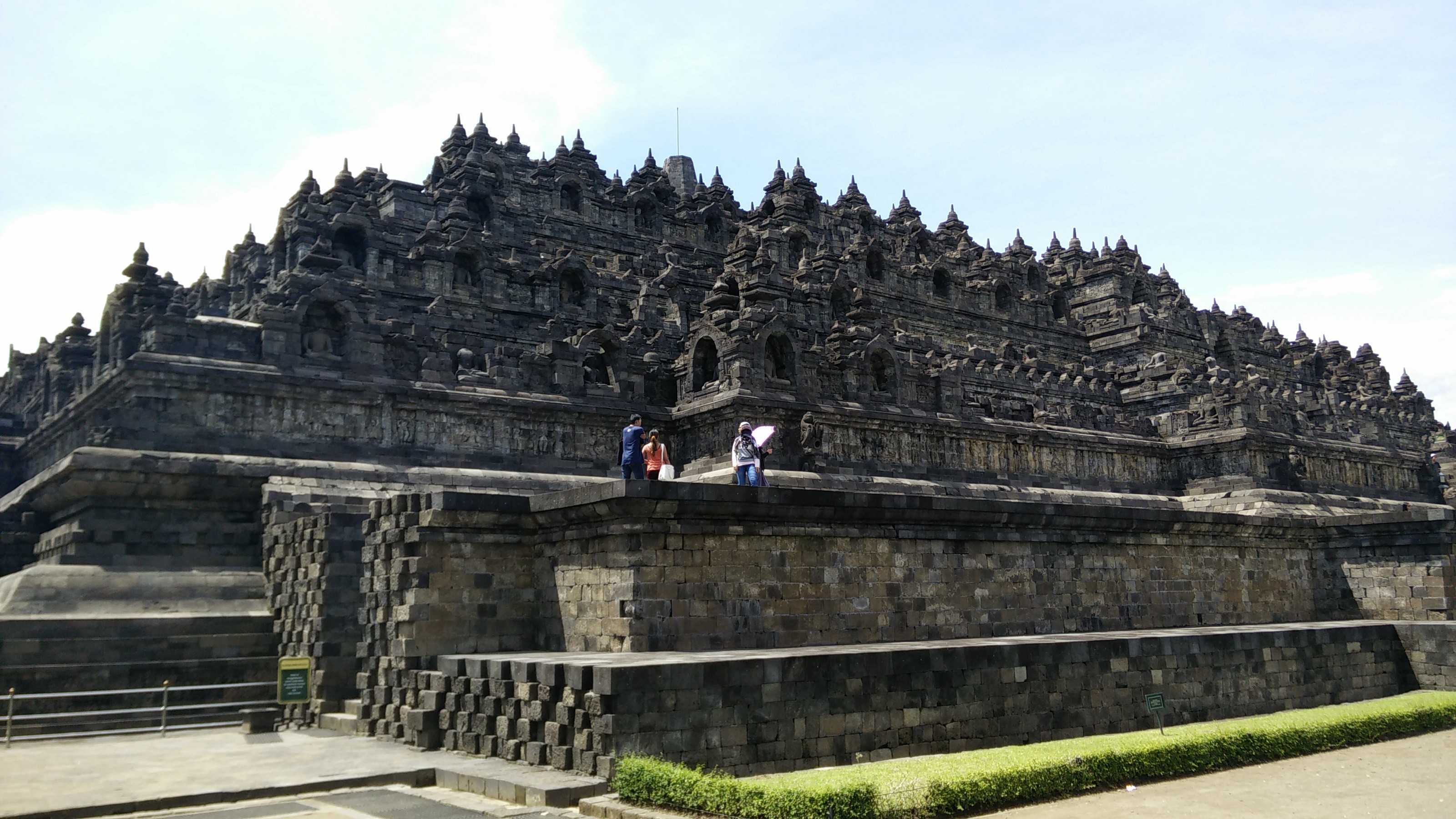last update: 03-08-2023
If you think about traveling in Indonesia or looking for information about Yogyakarta you have come to the right place. The weather is often great in Yogyakarta and the place offers a unique experience and culture. We will give you the information you are looking for and did not yet know all about Yogyakarta to make your visit there an unforgettable memory. We cover all the spots that could interest the traveler that comes to learn about the culture, food and broaden the life experience. There are a lot of activities to combine in a day and you could optimize your tour in Yogyakarta in 2 days, 4 days, or a week depending on what you want to experience and do. As a tourist staying any longer than a week, you would have to sacrifice some of your vacation time and possibly see less of beautiful Indonesia.
Yogyakarta or Jogjakarta
The Special Region of Yogyakarta is a unique province in Central South of Java in Indonesia. It is different from other places in Indonesia because it is a self-governed and autonomous place. The name Yogyakarta itself means: “The Vision to Perfect Society”. The main languages spoken here are Bahasa Indonesia and Bahasa Java. The V is pronounced as a W (Jawa). Currently, the English language over there is limited, but at the touristic hotspots, English is spoken. But do not expect when you ask for directions in English that you will be understood.
The location of Yogyakarta is in the Center-South of Java of Indonesia, on the Indian Ocean. The province has around 4 million inhabitants. (2014 was 4.592 source: Wikipedia). The capital is called Yogyakarta and has about 422k inhabitants. Whenever you hear Yogya, Jogja, Djokja they all are short and mean the city Yogyakarta. The people from East to West Java all have a different style of writing Jogjakarta or Yogyakarta.
Yogyakarta is also known to be a student city. Most universities in Indonesia are located here. The people come here to study at one of the universities from all over Indonesia.
There are around 730~ accommodations in. The price ranges from 75k IDR per night to 3+ Million IDR per night. For hostel-like experience to the super deluxe hotel in different locations for both far and near the city. In a separate article, we will provide the information suited best for you.
Yogyakarta Weather, when to go at the best months
Dry and Wet season. It can still rain in Dry Season like it won’t some days during the wet season. Yogyakarta Indonesia has two kinds of climates: the tropical monsoon (wet) and tropical savanna (dry). Around 5 months it will be a beautiful sunny vacation. In the table below are some statistics about the weather, temperature and rainfall in Yogyakarta.
The least rainfall happens from June, July, August, September, October. This is when Yogya is the best to visit.
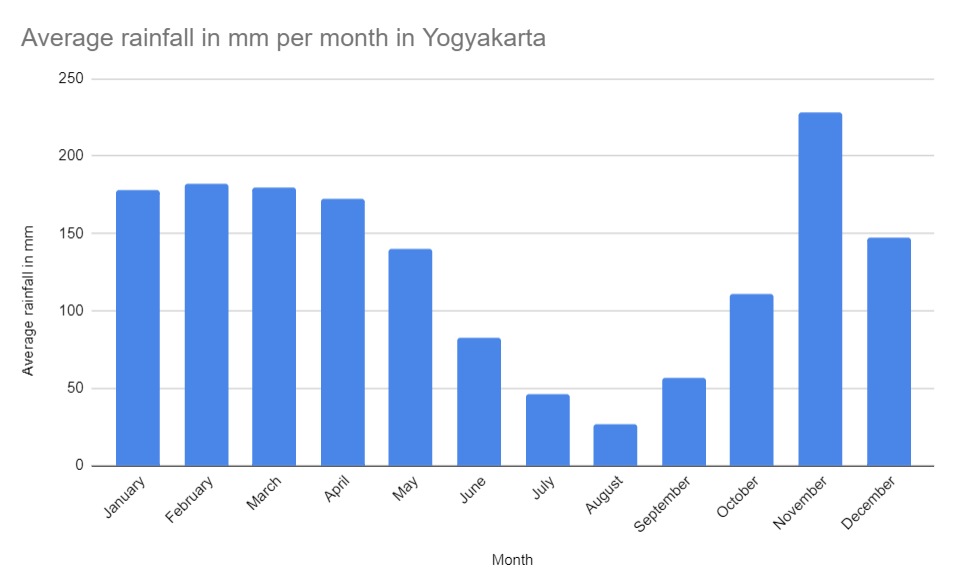

(source of the numbers)
Is Yogyakarta safe to come with children?
In short yes, but keep in mind that some areas like Malioboro can become very busy, and during the dry season it can become quite hot. Stay hydrated, make sure your children also have drinks available to them when they want. Think about planning a day with your children, some of the activities involve a lot of walking. Don’t exhaust your children also they are there to have a good time with you. Use caution as always when traveling with children.
The Heartbeat of Yogyakarta – History, Culture, and City Life
Yogyakarta, fondly known as Jogja, is the cultural nerve center of Java, Indonesia. Packed with a rich tapestry of history, tradition, and modern artistic expression, this city attracts both Indonesian and international students and tourists alike. With a relatively small population of around 400,000, the city presents an intimate setting for an immersive cultural exploration.
Historical Glance and Architectural Wonders
Yogyakarta is a living testament to Indonesia’s rich past, intertwining narratives of royalty, colonial rule, and timeless traditions. At the heart of this narrative is the Kraton, or the Sultan’s Palace. The opulence of the palace provides a stark contrast to the city’s otherwise humble infrastructure. With its sprawling size and intricate architecture, the palace is an imposing spectacle, yet a close look reveals an inviting aura, exuding warmth and timeless tradition.
The Kraton is not only an important monument but also the hub of cultural events and performances. The palace frequently hosts traditional Javanese dance recitals and Wayang Kulit (shadow puppet) shows, providing unique insights into Javanese folklore and legends.
A few steps away from the Kraton, the Taman Sari, or Water Castle, invites visitors into the royal leisure quarters of the past. This former bathing complex of the royal family showcases a striking amalgamation of Dutch and Javanese architectural styles, reflecting the historical Dutch influence on Indonesia. Taman Sari hosts a collection of pools, gardens, and buildings, each corner narrating its own story. Adding to the mystique of the Water Castle is the underground mosque or Sumur Gumuling. The mosque’s labyrinthine structure, converging into a central room with a pyramid-shaped staircase and a circular opening for daylight, presents a splendid view and a unique spiritual experience.
Malioboro Street for shopping, food, cultural adventure
Beyond the grandeur of royal heritage sites, Yogyakarta’s vibrant life pulsates in the bustling Malioboro Street. This iconic street market is a shopping haven, offering everything from street food stalls and local craft shops to clothing stores and art shops. The energetic vibe of Malioboro Street is truly captivating, with its bustling crowds, bright lights, and the aroma of street food wafting in the air. In the video you can see 2 girls dancing, attracting the crowd. A fast-paced music instrument that would decide the speed and rythm. It attracts a crowd, but be careful of your belongings while this is happening. You can donate some money if you’d like. During the day Malioboro is also a great oppurtunity to visit.
Walking down Malioboro Street, visitors are treated to a sensory feast of sights, sounds, and flavors. Be sure to savor local delicacies such as gudeg (a traditional Javanese dish made from unripe jackfruit) and bakpia (sweet rolls filled with a variety of fillings). Also, explore the plethora of shops selling traditional batik textiles, silverware, and unique handicrafts.
The Artistic Side of Yogyakarta
Amidst the hustle and bustle, the city’s affinity for art stands out prominently. In Mantrijeron, the city’s creative district, art, and culture seamlessly intertwine with everyday life. The narrow lanes are adorned with stunning murals, each echoing its unique voice and style. These pieces of street art are not just colorful additions to the city’s facade; they are the silent voices that reflect the city’s socio-cultural narratives and the unique Indonesian artistic expression.
Juxtaposing the historical charm of Taman Sari, the trendy street art scene, and the bustling market life of Malioboro, the city of Yogyakarta portrays an intriguing blend of the past and the present. A day of exploration within the city introduces you to a myriad of experiences – from the spiritual serenity of the underground mosque to the vibrant street life, the creative expressions on city walls, and the echoes of history within the sultan’s palace. It’s this fascinating blend of experiences that places Yogyakarta on the must-visit list of any Indonesian itinerary.
Travel Tips:
- It’s a good idea to get to Taman Sari complex early in the day, around 9 AM when it opens, to beat the crowds and enjoy a serene exploration.
- While shopping at Malioboro Street note that vendors have fixed prices. They have it written on some carton. Negotioting is almost not possible.
- The city offers a lot of different types of accommodation options to suit everyone’s budget. Take your pick from hostels, budget hotels, or luxury resorts. Many tourists choose to stay in the Mantrijeron area, which is close to many tourist attractions and offers a good choice of eateries.
Journeying Beyond The City – Yogyakarta’s Natural and Historical Wonders
Venturing beyond the city boundaries, Yogyakarta reveals a panorama of natural and historical wonders. From the majestic Mount Merapi to the awe-inspiring temples of Borobudur and Prambanan, these attractions are part of what makes Yogyakarta a compelling destination.
Mount Merapi: Basking in the Volcano’s Shadow
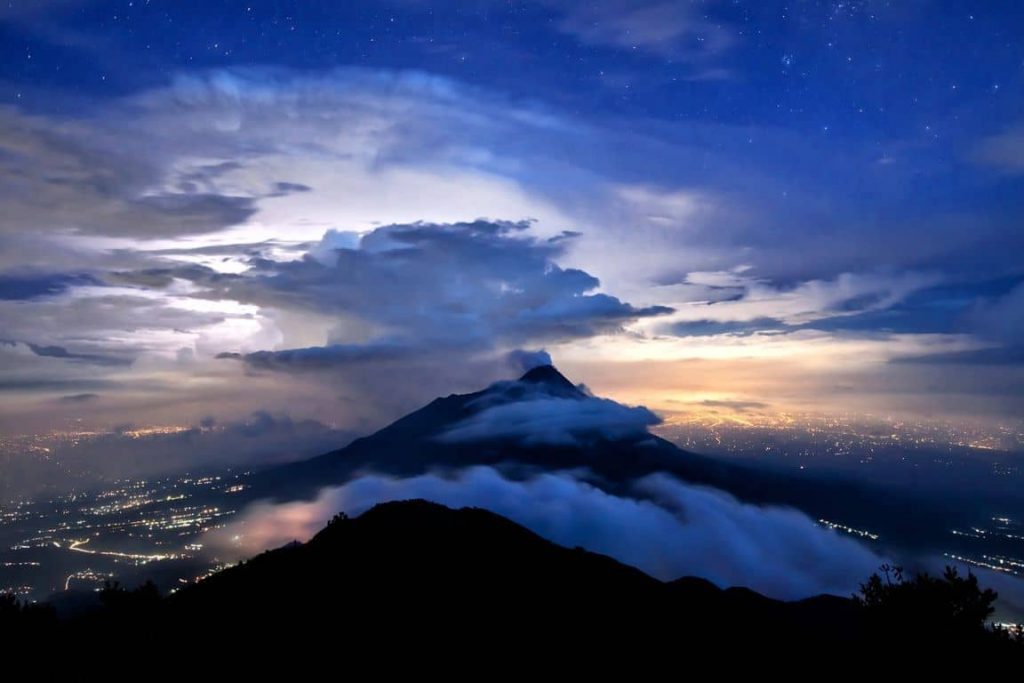
Rising majestically against the landscape, Mount Merapi serves as a powerful reminder of the forces shaping our world. Known as one of Indonesia’s most active volcanoes, Merapi holds a potent allure for adventurers and nature enthusiasts alike.
Undertaking the trek to the summit provides not just a test of one’s physical prowess, but also an experience of Yogyakarta’s stunning natural landscapes. Starting the trek before dawn, the journey to the summit reveals an ever-changing spectacle of hues as the sky shifts from inky blackness to vivid oranges and purples. Reaching the summit as the sun rises, one is rewarded with a breathtaking panoramic view of the landscape.
In the vicinity, Kaliadem, also known as Merapi Park, is another must-visit site. Devastated during Merapi’s 2010 eruption, the area has since been converted into a tourist spot, with several remnants serving as a stark reminder of nature’s force. Visitors can explore the “Bunker,” designed as a shelter during volcanic eruptions but ironically buried during the 2006 eruption, and “House of Memory,” a preserved house displaying items affected by the 2010 eruption.
The Temples of Borobudur and Prambanan
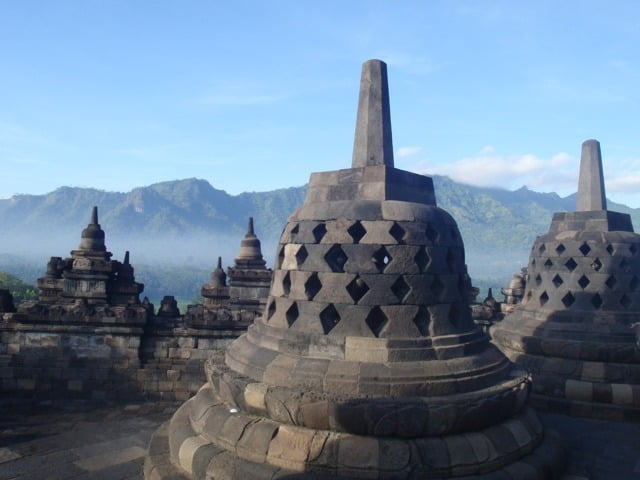
Yogyakarta’s iconic attractions, the temples of Borobudur and Prambanan, are magnificent testament to Indonesia’s religious history. The UNESCO World Heritage Sites serve as a rich tapestry of historical, cultural, and spiritual narratives that continue to fascinate visitors.
Borobudur, the world’s largest Buddhist temple, stands as a colossal monument layered with intricate carvings narrating Buddhist teachings. Exploring the temple’s ten terraces, each representing a different stage of enlightenment, visitors embark on a spiritual journey. The experience culminates with the top terrace, where the iconic bell-shaped stupas, each housing a Buddha statue, offer a view as captivating as the story they tell.
A short distance from Borobudur, Prambanan captivates with its dramatic Hindu narrative. The largest Hindu temple compound in Indonesia, Prambanan is a tribute to the Hindu Trimurti: Brahma, Vishnu, and Shiva. The main temples dedicated to these deities are adorned with intricate carvings depicting the Ramayana epic, making each visit a journey through a richly illustrated story.
TIP: For 70 USD you can get a guide that brings you to both of these temples. However this price does NOT include the entrance fee. This fee is another IDR 850 000 (55 USD). so your total for this day tour would be 125 USD. If you are with a group you can split the tour costs, but the entrance fee would still be applicable for everyone.
The Enigmatic Jomblang Cave
For a unique adventurous encounter, the Jomblang Cave offers an experience like no other. A vertical cave plunging approximately 60 meters deep, Jomblang requires one to descend using a single-rope technique (SRT), providing an exhilarating and unforgettable experience. Once at the bottom, a short trek leads to the cave’s star attraction, the “Heaven’s Light” – a beam of sunlight streaming through a hole in the cave’s ceiling, creating a mesmerizing sight.
Travel Tips:
- Booking a guided tour to Mount Merapi is recommended, as the trail can be challenging, and local guides have the necessary knowledge and equipment for a safe journey.
- For the best experience at Borobudur, plan a sunrise visit. The temple’s setting amidst lush greenery accentuated by the morning’s soft light creates a mystical ambiance.
- For visiting Jomblang Cave, pack a change of clothes, as you may get dirt all over during this activity. Also, remember to bring a headlamp or flashlight for exploring the darker parts of the cave.
Yogyakarta’s Hidden Gems:
While Yogyakarta’s main attractions are undeniably compelling, the city and its surrounding regions have even more to offer. From exploring unique museums to joining in traditional art workshops, the city brims with hidden gems and unique experiences waiting to be discovered.
The Affandi Museum: A Tribute to Expression
Tucked away in the city, the Affandi Museum pays tribute to one of Indonesia’s most celebrated expressionist artists, Affandi. His former home and studio, converted into a museum, offers a glimpse into his life and works. The gallery houses a significant collection of his vibrant paintings, while the museum’s unique architecture, designed by Affandi himself, is a masterpiece in itself. This intimate museum provides a rich insight into Indonesian art history and the creative genius of Affandi.
Ramayana Ballet: A Cultural Evening
While Yogyakarta offers numerous traditional performances, nothing quite compares to the grandeur of the Ramayana Ballet. Performed in the open-air theatre at the Prambanan temple complex, this dance drama tells the story of the Hindu epic Ramayana. With the illuminated Prambanan temples serving as a backdrop, hundreds of dancers and musicians bring to life the tale under the starlit sky. This magical performance, combining music, dance, and drama, offers a stunning cultural experience and a new perspective on the Prambanan temples.
It isn’t cheap as the price depending on group size can go up to $120! can be booked at Viator
Batik and Silver Workshops: Hands-On Traditional Crafts
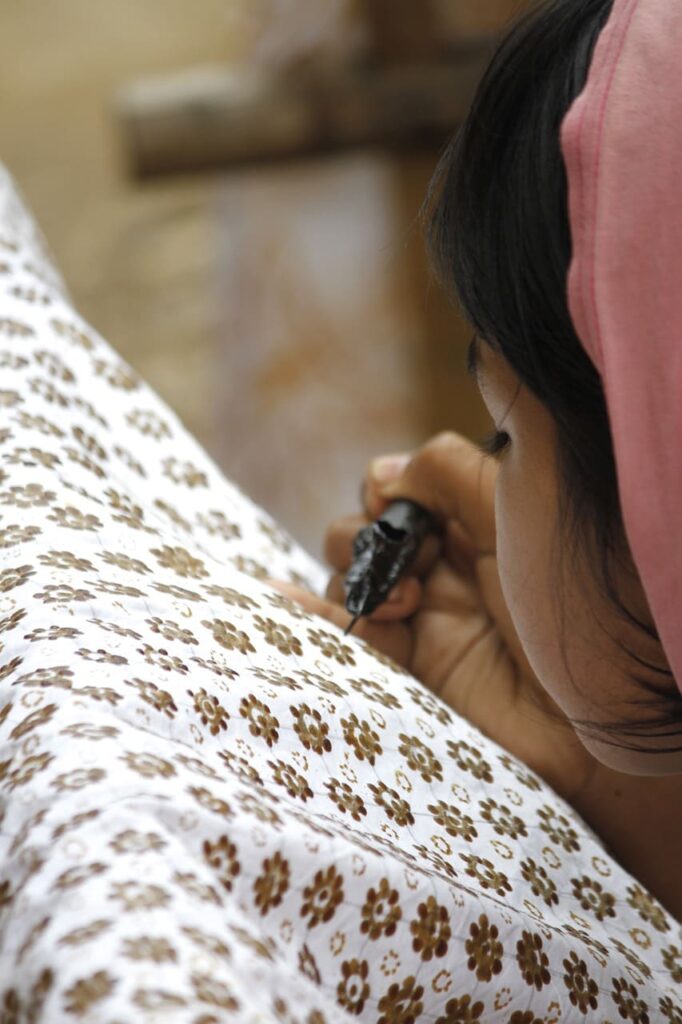
Embrace Yogyakarta’s artistic spirit by participating in a batik or silver workshop. Yogyakarta is famous for its batik, a traditional method of dyeing fabric using wax resist. In various studios throughout the city, you can learn this centuries-old craft, creating your unique piece of fabric art. Similarly, in Kota Gede, known for its fine silverware, you can join a silver workshop. Crafting a piece of jewelry or ornament under the guidance of skilled artisans, you’ll gain a deeper appreciation for these traditional arts.
Kalibiru National Park: Natural Serenity
A short drive from the city, Kalibiru National Park offers a peaceful retreat into nature. The park is known for its viewing points, where visitors can enjoy panoramic views of the Menoreh Hills and Sermo Reservoir. More than just a natural sanctuary, Kalibiru is also an adventure spot offering activities like zip-lining and tightrope walking. With its blend of natural beauty and adventure, Kalibiru provides a refreshing contrast to the city’s bustling pace.
Culinary Tour: A Taste of Yogyakarta
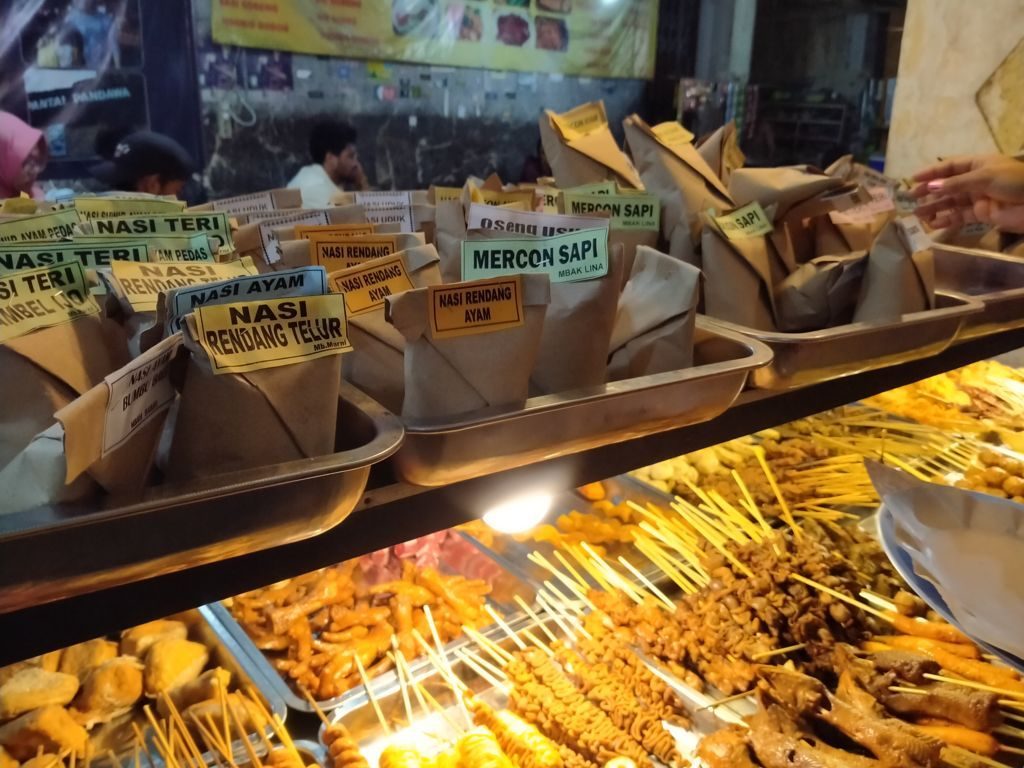
Beyond Gudeg and Bakpia, the culinary scene is incredibly diverse, especialy the street food of Yogyakarta. Embark on a culinary tour to sample a variety of local dishes. Try Nasi Kucing, a small serving of rice with toppings, wrapped in banana leaf, or Sate Klatak, a unique skewered mutton dish. Wash it down with a cup of Kopi Joss, coffee served with a piece of burning charcoal. Each bite and sip offers a taste of Yogyakarta’s culinary heritage. If you have the time try to visit Kopi Kotok, a very popular warung amongst Indonesians!
Summary: The Unseen Side of Yogyakarta
Yogyakarta is more than just its popular attractions. The city’s charm lies in its hidden corners, unique experiences, and vibrant tapestry of art and culture that unfolds at every step. Whether it’s the mesmerizing beauty of an expressionist painting, the grace of a ballet dancer, the excitement of crafting a piece of batik, the peacefulness of a national park, or the flavor of a traditional dish, each experience adds another layer to the Yogyakarta narrative.
Yogyakarta is an excellent destination for:
- Art lovers: The city’s museums and workshops offer a rich experience of Indonesian art.
- Culture enthusiasts: From traditional ballet performances to local cuisine, there’s much to explore.
- Adventure seekers: Whether it’s hiking in a national park or joining an art workshop, Yogyakarta offers unique experiences.
- Foodies: A culinary tour is an ideal way to taste Yogyakarta’s diverse cuisine.
- History buffs: Museums and historic buildings provide insights into the city’s past. Lots of Dutch influences visible in the architecture as well.
- Nature lovers: Natural parks around the city offer a break from the urban hustle.
- Families: With its variety of activities, Yogyakarta caters to all ages and interests.
- Solo travelers: The city’s welcoming environment makes it a comfortable destination for solo travel.
- Photographers: The city and its surroundings provide stunning visuals for photography.
- Shopaholics: From traditional markets to art shops, shopping opportunities abound.
- In conclusion, Yogyakarta invites you to go beyond the conventional and delve into its unseen side, offering an enriching journey that leaves you with lasting impressions and unforgettable memories.
Hi I am Dwi. I am a blogger, travel agent and a mom of a lovely daughter and wife to a supportive husband. I customize and plan tours in Bali and islands nearby for a living and have been doing this for more than 14 years. Get in touch via contact [at] taletravels.com
